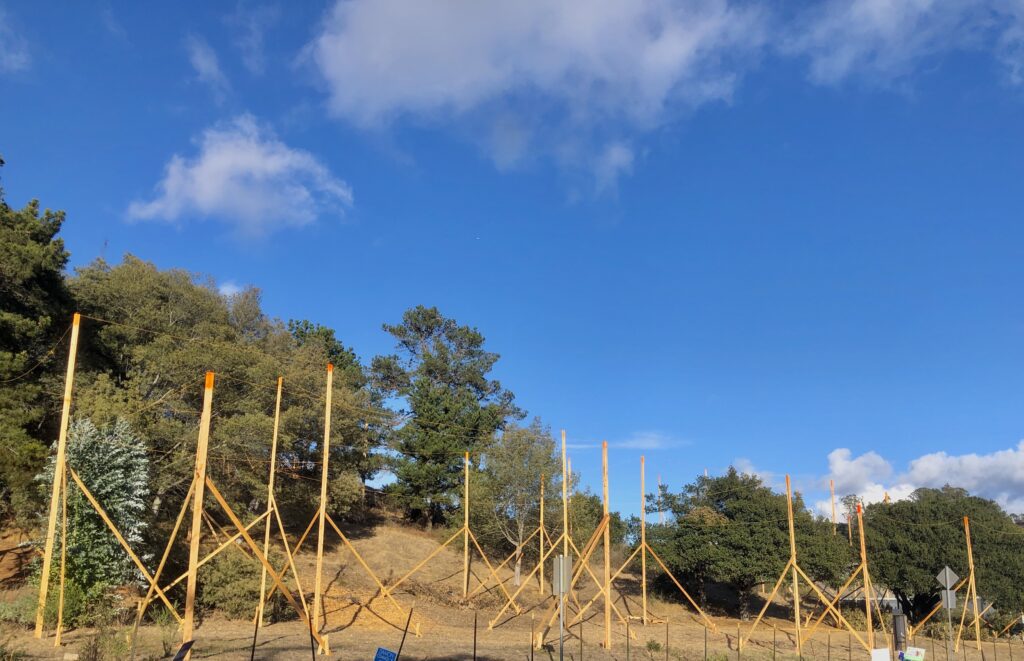
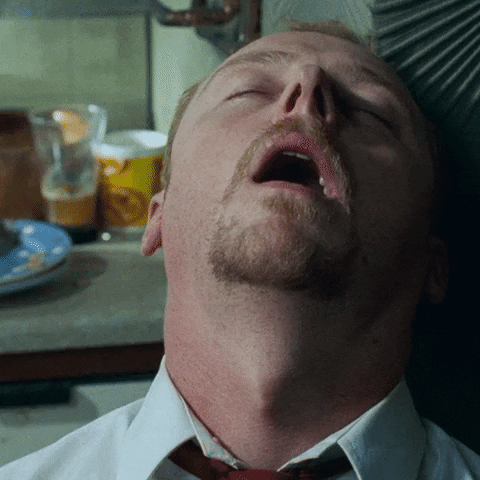
Ed. note: The Planning Commission hearing on the Richardson Terrace project lasted more than six hours.
“I’ve been working on this project for 18 years,” local developer Phil Richardson said in a brief project introduction, expressing his gratitude for city staff and his consultants “so that we can come up with a project that addresses the town’s concerns. I’m here to build some housing for Mill Valley, which I think it needs,” nodding to his pending agreement with the Mill Valley School District to purchase six affordable units for rental units for teachers and staff.
“I’m 87 years old, and I don’t want my wife to have to build this thing,” Richardson said when asked by councilmembers if he’d be willing to consider alternative versions to the project he was proposing.
Richardson’s architect, Mill Valley resident Mark Cavagnero, noted that the project’s mass was reduced to 80 percent of what’s allowed and the unit count as 74 percent of what he could build.
Eric Phillips, Richardson’s land use attorney, pointed out the litany of key local updates and California state law changes that have occurred since Richardson last proposed a development on Kite Hill in 2006. That includes the City of Mill Valley’s passage of a new General Plan in 2013, which created the land use and density standards with which the project complies. City officials also prepared and certified a full Environmental Impact Report that analyzed all the environmental impacts throughout the city and including at the site.
The bulk of the evening was spent with commissioners hearing commentary from local residents, starting with Jake Moskovitz, who kicked things off with a different tack than the yay-or-nay conversation that dominated much of the evening. “If we need to build as much housing (as is being included in our Housing Element), why are we leaving the opportunity to have even more housing on the site? How is that satisfying the housing needs as much as possible for the city?”
Blithedale Terrace resident Thomas McKlveen also spoke in favor of the proposal, saying that Richardson “has done everything that has been asked of him.”
Melanie Morgan of Altamont Ave. told the commission that she was initially opposed to the project but changed her mind in the intervening time. “I can’t ignore the need for housing in Mill Valley and in the Bay Area and I feel like it is something we need to deal with it.”
Most residents expressed concerns about the project. “You guys haven’t paid attention to what the community is saying to you,” said 40-year Mill Valley resident Carl Arena. “Do not be the bureaucrat who turns away from your constituents, the people who pay taxes here!”
“This housing could provide much-needed affordable housing to our educators,” said soon-to-be Tamalpais Union High School District trustee Emily Ulhorn. “We badly need housing of all kinds in Mill Valley. We are never going to get more housing if we don’t build to scale. We can choose to have more traffic coming down our freeways or we can say that we are committed here to having more housing in Mill Valley. I urge you to approve this as is.”
Nona Dennis, a Mill Valley resident since 1959 and environmentalist and former planning commissioner, said that one of the most egregious changes in recent decades have been “the proliferation of huge houses in the hills of Mill Valley, which don’t in any way satisfy the needs of the community. By all objective planning standards, this is an ideal location.”
Stalwart resistance very much remains. “This project is the most hair-brained thing I have ever seen in my life,” said Spencer Fast, a resident of Kite Hill Lane. “Let’s give (Richardson) $2 million and be done with it.”
We’ll update you in the coming days. For now, we’re going to take a nap, Enjoy our coverage from earlier this month below.
Here’s our earlier reporting from just prior to the hearing:
The emergence of the story poles last week for Phil Richardson’s latest attempt to build housing on his 575 Blithedale property have put the project’s size, scope, impact and possibilities front and center. Those considerations, along with the logistics of the business intersection of Camino Alto and East Blithedale Ave. itself, are the latest chapter in the longtime local builder’s enthusiastic attempt to develop a 1.2-acre property that he’s owned since 2004, facing stiff opposition ever since from neighbor groups that have packed public hearings, hired land-use attorneys and gone back and forth with him via sign wars.
Richardson is proposing a 25-unit proposal that calls for six 800-square foot affordable homes; six 800-square-foot homes designed for seniors, three 1,100-square-foot market rate homes and 10 2,100-square foot market rate homes. It also includes 2,240 square feet of ground floor commercial office space on a 1.2-acre site. Richardson proposes 12 of the housing units above the office space, including 11 two-bedroom units and 1 one-bedroom unit.
In doing so, Richardson retained award-winning architect Mark Cavagnero, a Mill Valley resident, to re-imagine the original street level design to fit in with the surrounding commercial buildings and draw elements from each of those existing buildings.
Earlier this month, city officials rescheduled a Planning Commission hearing for the developer’s Richardson Terrace to November 17 so as not to conflict with the November 8th election. The hearing will be held at 6:30pm at the Mill Valley Community Center’s Cascade Room at 180 Camino Alto. NOTE: The Community Center is not equipped with webcasting/streaming capabilities, so those wishing to speak at this hearing must attend in person or submit an e-comment. You will not be able to watch the hearing unless you are in the room. Staff will make a recording of this meeting available to the community after the meeting.
Mill Valley School District To Sign Letter of Intent to Buy Six Affordable Units Within Richardson Terrace
A unexpected narrative twist emerged Thursday when the Mill Valley School District board of trustees unanimously agreed to sign a letter of intent with Richardson’s Blithedale Terrace, LLC, to buy six below-market rate units for use as district workforce housing. The district intends to buy the six units and rent them at below market rates to teachers and staff employed in the district, according to the staff report. The agreement calls for three low-income units to be sold to the district for approximately between $264,000 and $335,000 and three moderate income units to be sold in the range of $319,000 to $405,000.
“In recognition of the fact that affordable housing is in short supply in the community and consistent with the desire of the district to attract and retain employees who would not otherwise be able to afford to live in the community, the district proposes to acquire the affordable housing units to use for workforce housing,” district officials wrote in a staff report on the matter. The letter of intent represents the first step in the acquisition process which will include negotiating an option agreement the following month and ultimately a purchase and sale agreement for the units.
California’s Changing Housing Landscape
In an additional twist that’s been building over the past six years, the legal foundation on which Richardson’s property stands has moved in a positive direction for him.
“Through boom, bust and pandemic, California’s Legislature has ended each legislative session with a blitz of new laws that aim to make housing more plentiful and affordable, according to the New York Times. Those legislative measures span from local faves like ADUs and a dismantling of single-family zoning rules to a pair of recent measures that aim to turn retail centers, office buildings and parking lots into potentially millions of future housing units — moves that caused many political observers to reconsider what is politically possible.
That shift hasn’t just happened in major cities like San Francisco and Los Angeles or even Marin’s larger cities like Novato and San Rafael. It’s come for small towns like Mill Valley, where city staff and its housing advisory committee gave the green light to a draft housing report that seeks to leverage a number of strategies to address the housing shortage in town, particularly a new Housing Element for years 2023-2031, a long-term, state-mandated process under the specter of ABAG’s Regional Housing Needs Allocation that calls for an eye-popping increase in the number of units to be planned for by the city, from 129 units in the 2014-2022 cycle to 865 units in 2023-2031.
City Hall is required to plan for, but not necessarily build, 865 units from now until 2031.
The housing shift hasn’t only been legislative. In 2020, the City of Mill Valley’s Diversity, Equity & Inclusion Task Force unveiled its full report and recommendations in the form of a 93-page, 28-recommendation, multiple ”wow”-inducing document that spanned an array of topics, including our community’s lack of affordable housing. “As in communities across the nation, housing segregation in Mill Valley has operated to establish and deepen racial disparities in wealth, education and other basic rights and opportunities,” the report stated. “Mill Valley’s soaring housing prices operate—by means of the racial wealth gap—to reinforce the exclusion of Black people and other people of color. Workers in Mill Valley’s service sector, many of them people of color, are forced to commute great distances due to the lack of affordable housing.”
Per City of Mill Valley affordable housing requirements, Richardson must provide 25% of the housing units (6 units) at below market sale prices. The Mill Valley Municipal Code requires the applicant sell three units at an affordable price to moderate-income households (up to 120% of the area median income – or AMI), and three units at an affordable price to low-income households (up to 80% of the AMI). These rates are set by the U.S. Department of Housing and Urban Development (HUD); please click here to learn more about qualifying incomes within Marin County.
When asked why he doesn’t just make the project 100 percent affordable, given the City Council’s focus on affordability with its plans to repurpose a portion of City-owned land at 1 Hamilton Drive into workforce housing in collaboration with EAH Housing, Richardson draws a distinction between his project as a private developer and those working with a nonprofit like EAH, which has multiple sources of revenue, or the San Clemente Place affordable property in Corte Madera.
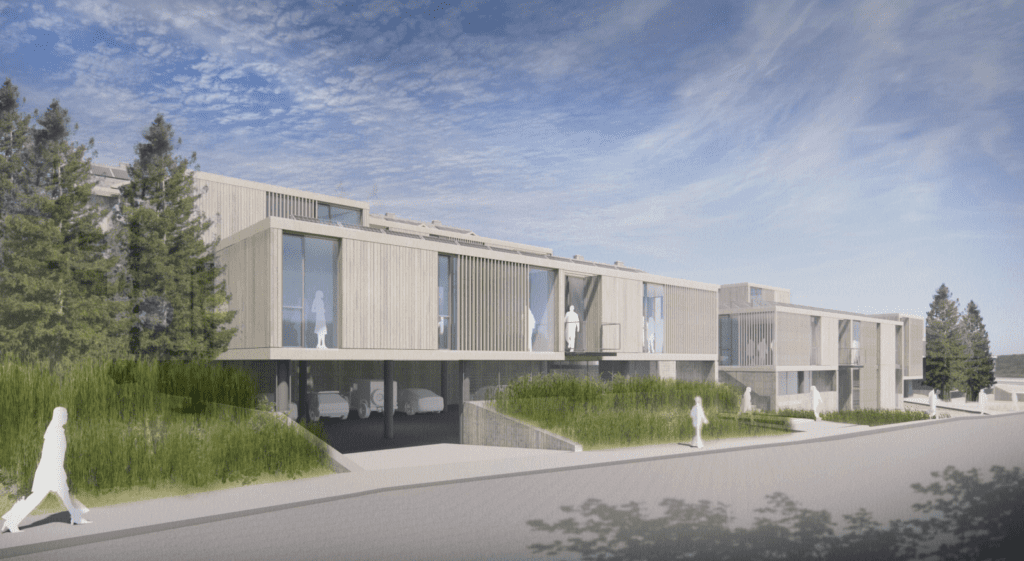
“In order to pay for those affordable units, I’ve got to build something on which I can make some money,” he says.
Richardson actually submitted the latest version of his project in 2020, but city officials had to conduct a number of studies to determine its initial feasibility. City staff and Lamphier-Gregory, the city’s environmental consultant for the project fully evaluated the environmental impacts of the proposed project pursuant to the California Environmental Quality Act (CEQA). The initial study prepared for the project provides substantial evidence that supports the conclusion that the project is categorically exempt from CEQA as an Infill Development pursuant to CEQA and that the project qualifies as a “project consistent with a Community Plan or Zoning” pursuant to CEQA guidelines.
The proposed property would feature, according to Richardson and his renowned architect Mark Cavagnero, enclosed parking and balconies for all homes; a small park with views; solar power and sophisticated home electronics included; an elevator; and incorporation as an HOA.
As Mill Valley residents know, the property is located near a number of commercial district, including the Alto Plaza shopping center on Blithedale, close proximity to the Mill Valley Middle School, Tam High and several elementary schools and the Mill Valley Community Center. The property is three blocks from the Hwy. 101 overpass.
HERE ARE THE DESIGN REVIEW PLANS FOR THE PROPOSAL.
HERE ARE THE INITIAL STUDY/CEQA EXEMPTION DOCUMENTS.
FAQs.
Here are some additional renderings of Richardson’s project, courtesy Mark Cavagnero Associates:

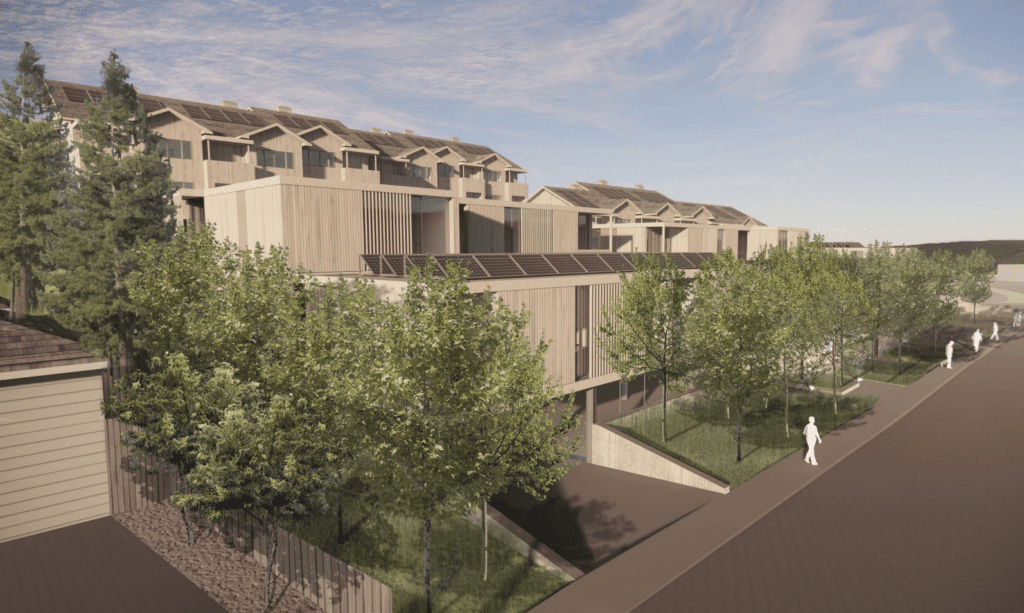

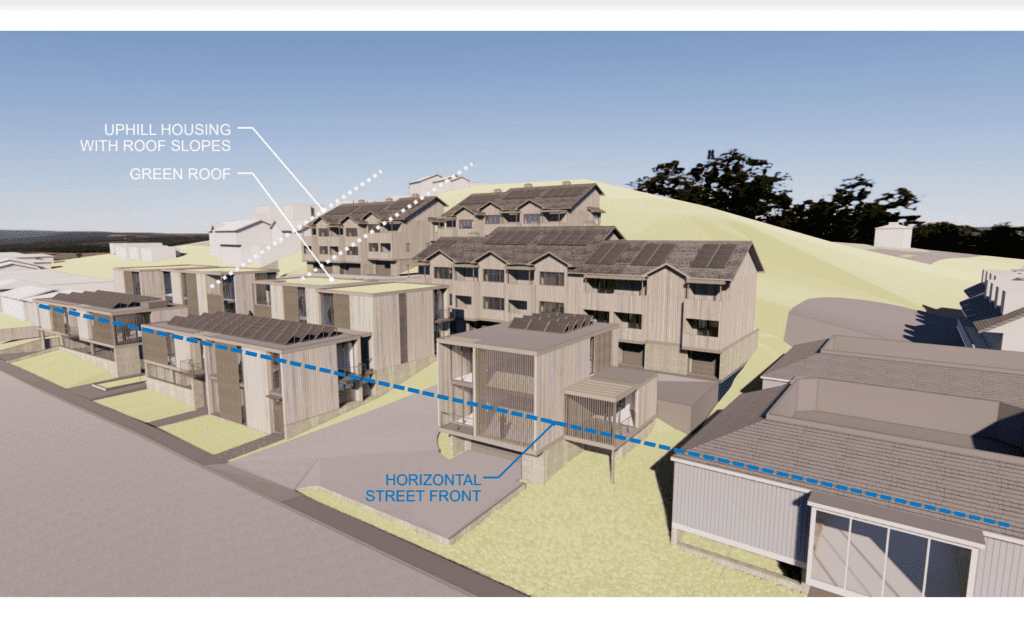

This article sways heavily into the applicants favor, making no mention of the 658+ residents who urged the commission to deny the proposed project, nor the countless suggestions made from the residents who live here and drive Blithedale on a daily basis. Most of us agree we need housing and are in favor of adding affordable housing wherever we can – but there has to be a better way to incorporate the safety, traffic and high density that doesn’t change our small town character. We have plenty of vacant commercial spaces that could be turned into housing. There are existing structures where we can add apartments and condos that are more affordable and an integrated into our community. This was the first public forum to discuss this proposal and more than 70% of those who spoke last night were not in favor of the current plan. Does the community’s input not matter? It’s disheartening to see development and profit take precedent over the people and community that have made this town so great to be a part. Would love to see better representation in this blog from both sides as we continue to debate. If you are against the current proposed plan at 575 E Blithedale, please sign the neighborhood petition https://chng.it/gtGjqmkz
This story contains several errors: a) Mr Richardson bought the property 18 years ago, yes, but there were multi-year gaps between different proposals, one for 6 years, and one for 8 years, with absolutely no activity; b) The City never certified an EIR. One was prepared in 2012 but never certified; c) Thomas McKlveen’s statement is incorrect – Mr Richardson may have done what city staff asked of him but he has consistently ignored all community and neighbor input since he presented his very first design; d) several people argued effectively that the project does not, in fact, comply with the General Plan, which describes our small-town character, etc. With several elements unchanged for earlier submittals, his project is very tall, too close to the street, and fails to comply with the current Housing Element. Just because the developer or a consultant make a statement does not make it true; opponents of the proposal as currently planned have presented several professional commentaries by credentialed experts which counter the city’s consultant.
I posted a politely-worded comment here correcting several inaccuracies in the lead article, and my comment has disappeared. is it the policy of this blog not to allow disagreements of opinion or corrections of fact?
Thank you for undeleting my first comment.